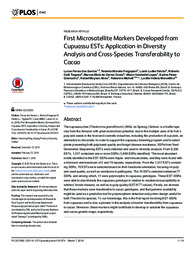First microsatellite markers developed from cupuassu ESTs: application in diversity analysis and cross-species transferability to cacao.
First microsatellite markers developed from cupuassu ESTs: application in diversity analysis and cross-species transferability to cacao.
Autoria: SANTOS, L. F. dos; FREGAPANI, R. M.; FALCAO, L. L.; TOGAWA, R. C.; COSTA, M. M. do C.; LOPES, U. V.; GRAMACHO, K. P.; ALVES, R. M.; MICHELI, F.; MARCELLINO, L. H.
Resumo: The cupuassu tree (Theobroma grandiflorum) (Willd. ex Spreng.) Schum. is a fruitful species from the Amazon with great economical potential, due to the multiple uses of its fruit´s pulp and seeds in the food and cosmetic industries, including the production of cupulate, an alternative to chocolate. In order to support the cupuassu breeding program and to select plants presenting both pulp/seed quality and fungal disease resistance, SSRs from Next Generation Sequencing ESTs were obtained and used in diversity analysis. From 8,330 ESTs, 1,517 contained one or more SSRs (1,899 SSRs identified). The most abundant motifs identified in the EST-SSRs were hepta- and trinucleotides, and they were found with a minimum and maximum of 2 and 19 repeats, respectively. From the 1,517 ESTs containing SSRs, 70 ESTs were selected based on their functional annotation, focusing on pulp and seed quality, as well as resistance to pathogens. The 70 ESTs selected contained 77 SSRs, and among which, 11 were polymorphic in cupuassu genotypes. These EST-SSRs were able to discriminate the cupuassu genotype in relation to resistance/susceptibility to witches? broom disease, as well as to pulp quality (SST/ATT values). Finally, we showed that these markers were transferable to cacao genotypes, and that genome availability might be used as a predictive tool for polymorphism detection and primer design useful for both Theobroma species. To our knowledge, this is the first report involving EST-SSRs from cupuassu and is also a pioneer in the analysis of marker transferability from cupuassu to cacao. Moreover, these markers might contribute to develop or saturate the cupuassu and cacao genetic maps, respectively.
Ano de publicação: 2016
Tipo de publicação: Artigo de periódico
Palavras-chave: Cacau, Cupuaçu, Fruta Tropical, Melhoramento genético
Observações
1 - Por padrão são exibidas publicações dos últimos 20 anos. Para encontrar publicações mais antigas, configure o filtro ano de publicação, colocando o ano a partir do qual você deseja encontrar publicações. O filtro está na coluna da esquerda na busca acima.
2 - Para ler algumas publicações da Embrapa (apenas as que estão em formato ePub), é necessário ter, no celular ou computador, um desses softwares gratuitos. Sistemas Android: Google Play Livros; IOS: iBooks; Windows e Linux: software Calibre.
Acesse outras publicações
Acesse a Base de Dados da Pesquisa Agropecuária (BDPA) para consultar o acervo completo das bibliotecas da Embrapa.

